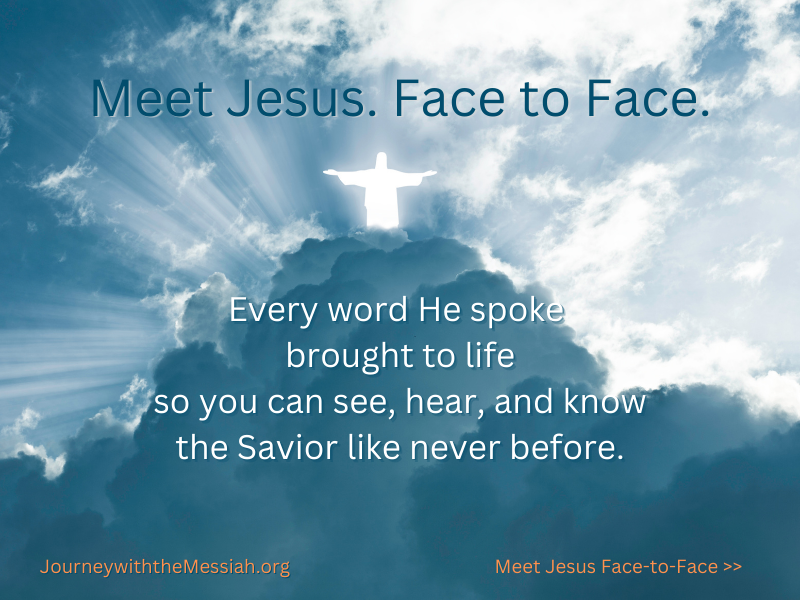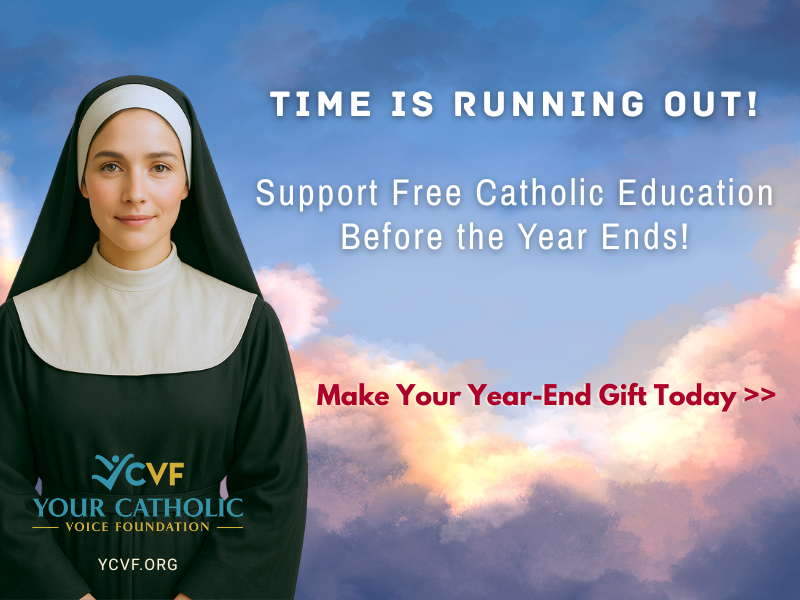 Dear readers, Catholic Online was de-platformed by Shopify for our pro-life beliefs. They shut down our Catholic Online, Catholic Online School, Prayer Candles, and Catholic Online Learning Resources essential faith tools serving over 1.4 million students and millions of families worldwide. Our founders, now in their 70's, just gave their entire life savings to protect this mission. But fewer than 2% of readers donate. If everyone gave just $5, the cost of a coffee, we could rebuild stronger and keep Catholic education free for all. Stand with us in faith. Thank you. Help Now >
Dear readers, Catholic Online was de-platformed by Shopify for our pro-life beliefs. They shut down our Catholic Online, Catholic Online School, Prayer Candles, and Catholic Online Learning Resources essential faith tools serving over 1.4 million students and millions of families worldwide. Our founders, now in their 70's, just gave their entire life savings to protect this mission. But fewer than 2% of readers donate. If everyone gave just $5, the cost of a coffee, we could rebuild stronger and keep Catholic education free for all. Stand with us in faith. Thank you. Help Now >
Archdiocese of New York
FREE Catholic Classes
ARCHDIOCESE OF NEW YORK (NEO-EBORACENSIS).
See erected 8 April, 1808; made archiepiscopal 19 July, 1850; comprises the Boroughs of Manhattan, Bronx, and Richmond in the City of New York, and the Counties of Dutchess, Orange, Putnam, Rockland, York; also the Bahama Islands (British Possessions); an area of 4717 square miles in New York and 4466 in the Bahama Islands. The latter territory was placed in 1886 under this jurisdiction by the Holy See because the facilities of access were best from New York; it formerly belonged to the Diocese of Charleston. The suffragans of New York are the Dioceses of Albany, Brooklyn, Buffalo, Ogdensburg, Rochester, and Syracuse in the State of New York, and Newark and Trenton in New Jersey . All these, in 1808, made up the territory of the original diocese. The first division took place 23 April, 1847, when the creation of the Diocese of Albany and Buffalo cut off the northern and western sections of the State; and the second, in 1853, when Brooklyn and Newark were erected into separate sees.
New York is now the largest see in population, and the most important in influence and material prosperity of all the ecclesiastical divisions of the Church in Continental United States.
I. COLONIAL PERIOD
Nearly a century before Henry Hudson sailed up the great river that bears his name, the Catholic navigators Verrazano and Gomez, had guided their ships along its shores and placed it under the patronage of St. Anthony . The Calvinistic Hollanders, to whom Hudson gave this foundation for a new colony, manifested their loyalty to their state Church by ordaining that in New Netherlands the " Reformed Christian religion according to the doctrines of the Synod of Dordrecht" should be dominant. It is probable, but not certain, that there were priests with Verrazano and Gomez, and that from a Catholic altar went up the first prayer uttered on the site of the present great metropolis of the New World. While public worship by Catholics was not tolerated, the generosity of the Dutch governor, William Kieft, and the people of New Amsterdam to the Jesuit martyr, Father Isaac Jogues, in 1643, and after him, to his brother Jesuits, Fathers Bressani and Le Moyne, must be recognized to their everlasting credit. Father Jogues was the first priest to traverse the State of New York ; the first to minister within the limits of the Diocese of New York. When he reached Manhattan Island, after his rescue from captivity in the summer of 1643, he found there two Catholics, a young Irishman and a Portuguese woman, whose confessions he heard.
St. Mary's, the first rude chapel in which Mass was said in the State of New York, was begun, on 18 November, 1655, on the banks of the lake where the City of Syracuse now stands, by the Jesuit missionaries, Fathers Claude Dablon and Pierre Chaumonot. In the same year another Jesuit, Father Simon Le Moyne, journeyed down the river to New Amsterdam, as we learn from a letter sent by the Dutch preacher, Megapolensis (a renegade Catholic ), to the Classis at Amsterdam, telling them that the Jesuit had visited Manhattan "on account of the Papists residing here, and especially for the accommodation of the French sailors, who are Papists and who have arrived here with a good prize." The Church had no foothold on Manhattan Island until after 1664, when the Duke of York claimed it for an English colony. Twenty years later, the Catholic governor, Thomas Dongan, not only fostered his own faith, but enacted the first law passed in New York establishing religious liberty. It is believed that the first Mass said on the island (30 October, 1683) was in a chapel he opened about where the custom house now stands. With him came three English Jesuits, Fathers Thomas Harvey, Henry Harrison, and Charles Gage, and they soon had a Latin school in the same neighborhood. Of this Jacob Leisler, the fanatical usurper of the government, wrote to the Governor of Boston, in August, 1689: "I have formerly urged to inform your Honr. that Coll Dongan, in his time did erect a Jesuite Colledge upon cullour to learn Latine to the Judges West -- Mr. Graham, Judge Palmer, and John Tudor did contribute their sones for sometime but no boddy imitating them, the colledge vanished" (O'Callaghan, "Documentary Hist. of N.Y.", II, 23).
With the fall of James II and the advent of William of Orange to the English throne, New York's Catholic colony was almost stamped out by drastic penal laws (see S TATE OF N EW Y ORK ). In spite of them, however, during the years that followed a few scattered representatives of the Faith drifted in and settled down unobtrusively. To minister to them there came now and then from Philadelphia a zealous German Jesuit missionary, Father Ferdinand Steinmayer, who was commonly called "Father Farmer". Gathering them together, he said Mass in the house of a German fellow-countryman in Wall Street, in a loft in Water Street, and wherever else they could find accommodation. Then came the Revolution, and in this connexion, owing to one of the prominent political issues of the time, the spirit of the leading colonists was intensely anti-Catholic. The first flag raised by the Sons of Liberty in New York was inscribed "No Popery". When the war ended, and the president and Congress resided in New York, the Catholic representatives of France, Spain, Portugal, with Charles Carroll, his cousin Daniel, and Thomas Fitz Simmons, Catholic members of Congress, and officers and soldiers of the foreign contingent, merchants and others, soon made up a respectable congregation. Mass was said for them in the house of the Spanish minister, Don Diego de Gardoqui, on Broadway, near the Bowling Green, in the Vauxhall Gardens, which was a hall on the river front near Warren Street, and in a carpenter's shop in Barclay Street. Finally, an Irish Capuchin, Father Charles Whelan, who had served as a chaplain to the Portuguese consul-general, Don José Roiz Silva, took up also the care of this scattered flock, which numbered less than two hundred, and only about forty of them practical in the observances of their faith.
Through efforts led by the French consul, Hector St. John de Crèvecoeur, an act of incorporation was secured, on 10 June, 1785, for the "Trustees of the Roman Catholic Church of the City of New York," in which José Roiz Silva, James Stewart, and Henry Duffin were associated with him as the first board. An unexpired lease of lots at Barclay and Church streets was bought from the trustees of Trinity church, Thomas Stoughton, the Spanish Consul-general, and his partner Dominick Lynch, advancing the purchase money, one thousand pounds, and there on 5 Oct., 1785, the cornerstone of St. Peter's, the first permanent structure for a Catholic church erected in the State of New York , was laid by the Spanish minister, Gardoqui. The church was opened 4 Nov., 1786. The first resident pastor was Father Whelan, who, however, was forced to retire owing to the hostility of the trustees and of another Capuchin, the Rev. Andrew Nugent, before the Church was opened. The prefect Apostolic, the venerable John Carroll, then visited New York to administer confirmation for the first time, and placed the church in charge of a Dominican, Father William O'Brien, who may be regarded as the organizer of the parish. He had as his assistants Fathers John Connell and Nicholas Burke, and, in his efforts to aid the establishment of the church, went as far as the City of Mexico to collect funds there under the auspices of his old schoolfellow, the archbishop of that see. He brought back $5920 and a number of paintings, vestments, etc. Father O'Brien and his assistants did heroic work during the yellow fever epidemics of 1795, 1799, 1801, and 1805. In 1801 he established the parish school, which has since been carried on without interruption. The Church debt at this time was $6500; the income from pew rents, $1120, and from collections, $360, a year. The Rev. Dr. Matthew O'Brien, another Dominican, the Rev. John Byrne, and the Rev. Michael Hurley, an Augustinian, were, during this period, assistants at St. Peter's. In July, 1807, the Rev. Louis Sibourd, a French priest, was made pastor, but he left in the following year, and then the famous Jesuit, Anthony Kohlman, was sent to take charge. It was at this time that the Holy See determined to erect Baltimore into an archbishopric and to establish the new Dioceses of New York, Philadelphia, Boston, and Bardstown, KY.
II. CREATION OF THE DIOCESE
We have a picture of the situation in New York when the first bishop was named: a letter sent on 8 Nov., 1808, by Father Kohlmann, who was then acting as the administrator of the diocese, to his friend Father Strickland, S.J., of London, England, says, "Your favour of the 6th Sept. was delivered to me at the beginning of October in the City of New York, where our Right Rev. Bishop Carroll has thought proper to send me in the capacity of rector of this immense congregation and Vicar General of this diocese till the arrival of the Right Rev. Richard Luke Concanen, Bishop of New York. The congregation chiefly consists of Irish, some hundreds of French, and as many Germans, in all according to the common estimation, of 14,000 souls. Rev. Mr. Fenwick, a young Father of our society, distinguished for his learning and piety, has been sent along with me. I was no sooner arrived in the city and, behold, the trustees, though before our arrival they had not spent a cent for the reparation and furniture of their clergyman's house, laid out for the said purpose above $800. All men seem to revive at the very name of the Society of Jesus, though yet little known in this part of the country." What rapid progress was made, he indicates, two years later, when, again writing to Father Strickland, on 14 Sept., 1810, he tells him: "Indeed it is but two years that we arrived in this city without having a cent in our pocket, not even our passage money, which the trustees paid for Father Fenwick and me . . . and to see things so far advanced as to see not only the Catholic religion highly respected by the first characters of the city, but even a Catholic college established, the house well furnished both in town and in the college improvements made in the college (sic) for four or five hundred dollars . . . is a thing which I am at a loss to conceive and which I cannot ascribe but to the infinite liberality of the Lord, to whom alone, therefore, be all glory and honour. The college is in the centre not of Long Island but of the Island of New York, the most delightful and most healthy spot of the whole island, at a distance of four small miles from the city, and of half a mile from the East and North rivers, both of which are seen from the house; situated between two roads which are very much frequented, opposite to the botanic gardens which belong to the State. It has adjacent to it a beautiful lawn, garden, orchard, etc." This spot is now the site of St. Patrick's Cathedral on Fifth avenue.
We can judge from the family names on the register of St. Peter's church that the early Catholics of New York were largely Irish ; next in number come the French, then the Germans, followed by those of Italians, Spanish and English origin. There were enough Germans in 1808 to think themselves entitled to a church and pastor of their own nationality, for on 2 March of that year Christopher Briehill, John Kneringer, George Jacob, Martin Nieder, and Francis Werneken signed a petition which they sent to Bishop Carroll praying him "to send us a pastor who is capable of undertaking the spiritual Care of our Souls in the German Language, which is our Mother Tongue. Many of us do not know any English at all, and these who have some knowledge of it are not well enough versed in the English Language as to attend Divine Service with any utility to themselves. As we have not yet a place of worship of our own, we have made application to the Trustees of the English Catholic Church in this city to grant us permission to perform our worship in the German Language in their church at such times as not to interfere with their regular services. This permission they have readily granted us. During the Course of the year we shall take care to find an opportunity to provide ourselves with a suitable building of our own, for we have no doubt that our number will soon considerably increase." Nothing came of this petition, and no separate German congregation was organized in New York until a quarter of a century after its date. But Father Kohlmann saw to it that another church should be started, and St. Patrick's was begun "between the Broadway and the Bowery road" in 1809, to meet the needs of the rapidly increasing number of Catholics on the east side of the city. It was also to serve as the cathedral church of the new diocese. The corner-stone was laid 8 June, 1809, but, owing to the hard times and the war of 1812 with England, the structure was not ready for use until May, 1815, when it was dedicated by Bishop Cheverus who came from Boston for that purpose. It was then far on the outskirts of the city, and, to accustom the people to go there, Mass was said at St. Peter's every other Sunday. The ground on which it was built was purchased in 1801 for a graveyard, and the interments in it from that time until the cemetery was closed in 1833 numbered 32,153. Some of the Catholic laymen prominent during this period were Andrew Morris, Matthew Reed, Cornelius Heeney , Thomas Stoughton, Dominick Lynch, Benjamin Disobrey, Peter Burtsell, uncle of the Rev. James A. Neil, the first native of New York to be admitted to the priesthood, Joseph Icard, merchant and architect, Hugh McGinnis, Dennis Doyle, Miles F. Clossey, Anthony Trapanni, a native of Meta, Italy, pioneer Italian merchant and the first foreigner to be naturalized under the Constitution, Francis Varet, John B. Lasala, Francis Cooper, George Gottsberger, Thomas O'Connor, Thomas Brady, Dr. William James Maneven, and Bernard Dornin, the first Catholic publisher, for whose edition of Pastorini's "History of the Church," issued in 1807, there were 318 New York City subscribers.
III. THE HIERARCHY A
When Bishop Carroll learned that it was the intention of the Holy See to recognize the growth of the Church in the United states by dividing the Diocese of Baltimore and creating new sees, he advised that New York be placed under the care of the Bishop of Boston till a suitable choice could be made for that diocese. Archbishop Troy of Dublin, however, induced Pius VII to appoint as New York's first bishop an Irish Dominican, Father Richard Luke Concanen, who had resided many years in Rome as the agent of the Irish bishops and was much esteemed there. He was prior of St. Clement's at Rome, librarian of the Minerva, and distinguished for his learning. He had refused a nomination for a see in Ireland and was much interested in the missions in America, about which he had kept up a correspondence with Bishop Carroll. It was at his suggestion that Father Fenwick founded the first house of the Dominicans in Kentucky. He was consecrated first Bishop of New York at Rome, 24 April, 1808, and some time after left for Leghorn on his way to his see, taking with him the pallium for Archbishop Carroll. After waiting there for a ship for four months he returned to Rome. Thence he went to Naples, expecting to sail from that port, but the French military forces in possession of the city detained him as a British subject, and, while waiting vainly to be released, he died of fever, 19 June, 1810. Finding that he could not leave Italy, he had asked the pope to appoint the Rev. Ambrose Ambrose Maréchal to be his coadjutor bishop in New York. The American bishops cordially endorsed this choice and considered that the appointment would be made. Archbishop Carroll , writing to Father C. Plowden , of London, 25 June, 1815, said: "It was known here that before the death of Dr. Concanen his Holiness at the Dr's entreaty intended to assign him as his coadjutor the Rev. Mr. Ambrose Maréchal, a priest of St. Sulpice, now in the Seminary here, and worthy of any promotion in the Church. We still expected that this measure would be pursued; and that we made no presentation or recommendation of any other for the vacant see."
BArchbishop Troy, of Dublin, however, with the other Irish bishops, proposed to the pope another Irish Dominican, the Rev. John Connolly, for the vacant see of New York, and he was consecrated at Rome, 6 Nov., 1814. It was a selection which might have proved embarrassing to American Catholics, for Bishop Connolly was a British subject, and the United States was then at war with Great Britain. "I wish," wrote Archbishop Carroll to Father Plowden, 25 June, 1815, "this may not become a very dangerous precedent fruitful of mischief by drawing upon our religion a false opinion of the servility of our principles." Owing to his own views of the situation in the diocese, Bishop Connolly did not announce his appointment to his fellow-members of the hierarchy or to the administrator of the diocese. Father Kohlmann was, therefore, in anticipation of the bishop's arrival, recalled by his superiors to Maryland, the college was closed, and the other Jesuits soon after left the diocese. Finally, Bishop Connolly arrived in New York unannounced, and without any formal local welcome, 24 Nov., 1815, his ship taking sixty-eight days to make the voyage from Dublin. In the diocese he found that everything was to be created from resources that were very small and in spite of obstacles that were very great. The diocese embraced the whole State of New York and half of New Jersey. There were but four priests in this territory. Lay trustees had become so accustomed to having their own way that they were not disposed to admit even the authority of a bishop. Dr. Connolly was not wanting in firmness, but the pressing needs of the times, forcing an apparent concession to the established order of things, subjected him to much difficulty and many humiliations. He was a missionary priest rather than a bishop, as he wrote Cardinal Litta, Prefect of Propaganda, in February, 1818, but he discharged all his laborious duties with humility and earnest zeal. His diary further notes that he told the cardinal : "I found here about 13,000 Catholics. . . At present there are about 16,000 mostly Irish ; at least 10,000 Irish Catholics arrived at New York only within these last three years. They spread through all the other states of this confederacy, and make their religion known everywhere. Bishops ought to be granted to whatever here is willing to erect a Cathedral, and petition for a bishop. . . The present dioceses are quite too extensive. This burden hinders us from supporting a sufficient number of priests, or from thinking to erect a seminary. The American youth have an invincible repugnance to the ecclesiastical state."
He made a visitation of the diocese, no mean accomplishment at that time ; provided churches for the people in Brooklyn, Buffalo, Albany, Utica, and Paterson; introduced the Sisters of Charity, started the orphan asylum , and encouraged the opening of parish schools. He died at his residence, 512 Broadway, 5 Feb., 1825, worn out by is labours and anxieties. Notable men of this period were Fathers Michael O'Gorman and Richard Bulger -- the latter the first priest ordained in New York (1820) -- Charles D. Ffrench, John Power, John Farnan, Thomas C. Levins, Philip Larisey and John Shannahan. There were several distinguished converts, including Mother Seton, founder of the American branch of the Sisters of Charity; the Rev. Virgil Barber and his wife, the Rev. George E. Ironside, Keating Lawson, and others. Two years elapsed before the next bishop was appointed, and the Rev. Dr. John Power during that period governed the diocese as administrator. Brooklyn's first church was organized during this time. It was during Bishop Connolly's administration also, that New York's first Catholic paper "The Truth Teller" was started, on 2 April, 1825.
CThe choice of the Holy See for the third bishop was the Rev. Dr. John Dubois, president of Mount St. Mary's College , Emmitsburg and he was consecrated at Baltimore, 29 October, 1826. The Rev. William Taylor, a convert who had come from Cork, Ireland, in June, 1818, at the suggestion of Bishop England of Charleston, endeavoured to be himself made bishop, going to Rome in January, 1820, for that purpose. The visit to Rome being fruitless, Taylor went to Boston, where he remained several years with Bishop Cheverus, returning to New York when that prelate was transferred to France. He was exceedingly popular with non-Catholics because of his liberality. He preached the sermon at the consecration of Bishop Dubois and used the occasion to expatiate on what he called "disastrous experiences which resulted to religion from injudicious appointments", hinting at coming trouble for the bishop in New York. He left New York simultaneously with the arrival of the bishop there, and sailed for France, where his old friend Mgr. Cheverus, then Archbishop of Bordeaux, received him. He died suddenly, while preaching in the Irish college, Paris, in 1828.
None of the predicted disturbances happened when Bishop Dubois took possession of his see, though the abuse of trusteeism, grown more and more insolent and unmanageable by toleration, hampered his efforts from the very start. Fanaticism was aroused among the Protestant sects, alarmed at the numerical increase of the Church through the immigration attracted by the commercial growth of the State. But in spite of all, he went on bravely visiting all parts of the State, building and encouraging the building of churches wherever they were needed, obtaining aid from Rome and from the charitable in Europe. He found but two churches in the city when he came; to these he added six others and multiplied for his flock the facilities for practising their religion, his constant endeavour being to give his people priests, churches, and schools. With the trustees in New York City and in Buffalo he had many sad experiences, but he unflinchingly upheld his constituted authority. In 1834 he organized, with the Rev. John Raffeiner as pastor, the first German Catholic congregation in New York in a small disused Baptist church at Pitt and De Lancey Streets, which became the church of St. Nicholas. It was about this time, too, that a public controversy over Catholic doctrine raged between the Calvinist ministers, Rev. John Breckenridge and Rev. William Brownlee, and the vicar-general, Rev. Dr. Power, assisted by Fathers Varela, Levins, and Schneller. It was followed by the fanatical attack on Catholic religious communities known as "The Awful Disclosures of Maria Monk ". Dr. Dubois "had then reached the age of seventy and, though still a vigorous combatant when necessary, was disinclined to religious controversy. Perhaps he did not understand the country and the people as well as the younger men who had grown up in America; perhaps he was deterred by his memories of the French Revolution " (Hebermann, "His. Records and Studies", I, Pt. 2, 333).
At length the many burdens and anxieties of his charge told on the bishop, and he asked for a coadjutor, naming the Right Rev. P.F. Kenrick , Coadjutor of Philadelphia, as his first choice, and the Rev. Thomas F. Mulledy, S.J., and the Rev. John Hughes, of Philadelphia, as alternates. Father Hughes, of Philadelphia, who had been his pupil at Emmitsburg, was selected and consecrated titular Bishop of Basileo, 7 January, 1838. His youth and vigour soon put new life into the affairs of the Church in New York, and were especially efficient in meeting the aggressions of the lay trustees. Bishop Hughes had fully realized the dangers of the system as shown in Philadelphia, and he lost no time in meeting and crushing it in New York. Bishop Dubois, through ill health, had to relinquish the details of his charge more and more to his youthful assistant, whose activity he warmly welcomed. Several attacks of paralysis warned him to give up the management of the diocese. His remaining days he spent quietly preparing for the end, his coadjutor ever treating him with respectful kindness and sympathy. He died 20 December, 1840, full of years and merits. Those of his assistants who were notably prominent were Father Felix Varela, an eminently pious and versatile priest, an exile from Cuba, and the Revs. Joseph Schneller, Dr. Constantine C. Pise , Alexander Mupietti, John Raffeiner, the pioneer German pastor ; Hatton Walsh, P. Malou, T. Maguire, Michael Curran, Gregory B. Pardow, Luke Berry, John N. Neumann, later a Redemptorist and Bishop of Philadelphia, and John Walsh, long pastor of St. James, Brooklyn.
DBishop Hughes, the administrator, at once assumed the title of the see as its fourth bishop, and is the really great figure in the constructive period of New York's history. "It was a day of great men in the civil order", says the historian, Dr. John Gilmary Shea, "the day of Clay, Webster, Calhoun, yet no man of that era spoke so directly or so effectively to the American people as Bishop Hughes. He was not an ordinary man. It had been well said that in any assemblage he would have been notable. He was full of noble thoughts and aspirations and devoted to the Church ; every plan and every project of his mind aimed at the greater good of the country". The story of his eventful career is told in a separate article , and it will suffice to mention here some of the many distinguished men who helped to make his administration so important in local records. Among them were the Rev. William Quarter, afterwards first Bishop of Chicago, and his brother, the Rev. Bernard O'Reilly, first Bishop of Hartford ; the Rev. John Loughlin, first Bishop of Brooklyn ; the Rev. James R. Bayley, first Bishop of Newark and Archbishop of Baltimore ; the Rev. David Bacon, first Bishop of Portland ; the Rev. William G. McCloskey, first rector of the American College at Rome and fourth Bishop of Louisville, Ky., son of one of the Brooklyn pioneers; the Rev. Andrew Byrne, first Bishop of Little Rock ; the Rev. John J. Conroy, Bishop of Albany ; the Rev. William Starrs, vicar-general ; the Rev. Dr. Ambrose Manahan, the Rev. John Kelley (Eugene Kelly's brother), who went as a missionary to Africa and then became first pastor at Jersey City. These are only a few of the names that are prominent. Among the notable converts of this period may be mentioned the Rev. Thomas S. Preston, J.V. Huntington, F.E. White, Donald McLeod, Isaac T. Hecker, A.F. Hewit, Alfred Young, Clarence Walworth, and Edgar P. Wadhams, later Bishop of Ogdensburg.
EAs the successor of Archbishop Hughes, Bishop John McCloskey of Albany was promoted to be the second archbishop. He had been consecrated Coadjutor of New York, with the right of succession, in 1844, but resigned both offices to become the first bishop of Albany in 1847 (see MCCLOSKEY, JOHN). He returned to New York in spite of his own protests of unworthiness, but with the unanimous approval and rejoicing of the clergy and laity. He was born in Brooklyn, 10 March, 1810, and was therefore the first native bishop, as he was the second native of New York to be ordained to the priesthood. He was a gentle, polished, amiable prelate, and accomplished much for the progress of Catholic New York. The Protectory, the Founding Asylum, and the Mission of the Immaculate Virgin for homeless children were founded under his auspices; he resumed work on the new Cathedral, and saw its completion; the provincial seminary at Troy was organized; churches, schools, and charitable institutions were everywhere increased and improved. In the stimulation of a general appreciation of the necessity of Catholic education the cardinal (he was elevated to the Purple in 1875) was incessant and most vigorous. He saw that the foundations of the structure, laid deep by his illustrious predecessor, upheld an edifice in which all the requirements of modern educational methods should be found. Like him, also, as years crept on, he asked for a coadjutor, and the Bishop of Newark, Michael Augustine Corrigan , was sent to him.
FBorn in Newark, 31 August, 1839, his college days were spent at Mt. St. Mary's, Emmitsburg, and at Rome. Ordained in 1863, Bishop Corrigan became president of Seton Hall College in 1868, Bishop of Newark in 1873, Coadjutor of New York in 1880, and archbishop in 1885. He died, from an accidental fall during the building of the Lady Chapel at the Cathedral, 5 May, 1902. It was said of him by the New York "Evening Post": "The memory of his life distils a fragrance like to that of St. Francis." By some New Yorkers he was for a time a much misunderstood man, whose memory time will vindicate. Acute thinkers are appreciating his worth as a civilian as well as a churchman, and the fact that, for Catholics, he grappled with the first menacing move of Socialism and effectually and permanently checked its advance. He was an administrator of ability and, socially, a man of winning personality. To the serious problem of providing for the spiritual need of the inrushing thousands of European immigrants he gave successful consideration. The splendid seminary at Dunwoodie is his best memorial. Its beautiful chapel he built at a cost of $60,000 -- his whole private inherited fortune. During his administration controversy over the school question was waged with a certain amount of acrimony. He was regarded as the leader of those all over the country who stood for uncompromising Catholic education. Archbishop Corrigan was also drawn into conflict with the Rev. Dr. Edward McGlynn, rector of St. Stephen's church, a man of considerable ability, but whose radical views on the ownership of land had brought on him the official censure of Cardinal Simeoni, Prefect of Propaganda. In the municipal election of 1886, in spite of the archbishop's warnings, he became the open partisan of Henry George who was the candidate for mayor of the Single Tax Party. As a consequence, he was suspended, and, as an alumnus of the College of Propaganda, was summoned to Rome to answer the charges made against him. He refused to go and was excommunicated. -- For details and tect of official letters, see Archbishop Corrigan's statement to New York papers (21 January, 1887) and Dr. McGlynn's formal answer in Henry George's "Standard" (5 February, 1887). -- Dr. McGlynn's partisans organized themselves into what they called the Anti-Poverty Society. He addressed this body every Sunday until about Christmas, 1892, when, having willingly accepted the conditions laid down by the pope, he was absolved from censure and reconciled by Mgr. Satolli, the Apostolic delegate. According to a published statement by Mgr. Satolli , the conditions were in this form: "Dr. McGlynn had presented a brief statement of his opinions on moral-economic matters, and it was judged not contrary to the doctrine constantly taught by the Church, and as recently confirmed by the Holy Father in the encyclical ' Rerum Novarum '. Also it is hereby made known that Dr. McGlynn, besides publicly professing his adherence to all the doctrines and teachings of the Catholic Church, has expressed regret (saying that he would be the first to regret it) for any word or act of his that may have seemed lacking in the respect due to ecclesiastical authority, and he hereby intends to repair as far as he can any offense which may have been given to Catholics. Finally, Dr. McGlynn has of his own free will declared and promised that, within the limits of a not long period of time, he will go to Rome in the spirit and intention which are becoming to a good Catholic and a priest." In 1894 Dr. McGlynn was appointed pastor of St. Mary's church, Newburg, where he remained quietly until his death in 1901.
Archbishop Corrigan made his last visit ad limina in 1890 and after his return, until his death in 1902, devoted himself entirely to the duties of his high office. His death brought out the fact that he was the foremost figure of the community in the respect and affection of his fellow-citizens. His unassuming personality and his gentle method, his considerate kindness and his unaffected piety were pathways t the love and veneration of his flock. His steadfast adherence to principle, as well as his persuasive manner of, not only teaching, but also of acting out the doctrines of his religion, his profound scholarship, his experienced judgment, were ever employed when there was a question of a religious, moral, or civil import to his fellow-men. The truth of this is to be found in the testimony of Leo XIII, himself, of the civil dignitaries of the land, of his brethren in the episcopate, of his own clergy and laity, on the mournful occasion of his death. Under the second and third archbishops, Mgr William Quinn, V.G., was a prominent figure, and among his associates of this era were Mgr Thomas S. Preston, Mgr Arthur J. Donnelly, Mgr James McMahon, Mgr P. F. McSweeny, Fathers Farrelly, Eugene McGuire, Thomas Farrell, Edward J. O'Reilly, M.J. O'Farrell, (later Bishop of Trenton ), and Edmund Aubril.
GAs fourth archbishop, the Holy See confirmed the choice of the diocesan electors, and appointed to fill the vacancy the auxiliary, the Right Rev. John Murphy Farley, titular Bishop of Zeugma, who was promoted to the archbishopric 15 September, 1902. He was born at Newton Hamilton, County Armagh, Ireland, 20 April, 1842. His primary studies were made at St. McCartan's College, Monaghan, and, on his coming to New York, were continued at St. John's College, Fordham. Thence he went to the provincial seminary at Troy for his philosophy course, and after this to the American College, Rome, where he was ordained priest 11 June, 1870. Returning to New York, he ministered as an assistant in St. Peter's parish, Staten Island, for two years, and in 1872 was appointed secretary to the then Archbishop McCloskey, in which office he served until 1884, when he was made pastor of St. Gabriel's church, New York City. He accompanied the cardinal to Rome in 1878, for the election of Leo XIII, which event, however, took place before their arrival. In 1884 he was made a private chamberlain; in 1892 he was promoted to the domestic prelacy, and in 1895 to be prothonotary apostolic . In 1891 he was chosen vicar-general of the diocese by Archbishop Corrigan, and, on 21 December, 1895, was consecrated as his auxiliary, with the title of Bishop of Zeugma. At the death of Archbishop Corrigan, he was appointed his successor, 15 Sept., 1902, and Pius X named him assistant at the pontifical throne in 1904. He made progress in Catholic education in the diocese the keynote of his administration, and within the first eight years added nearly fifty parochial schools to the primary list, encouraged the increase also of high schools and founded Cathedral College as a preparatory seminary.
In the proceedings of the annual convention of the Catholic Educational Association held in New York in 1903, and of the National Eucharistic Congress in 1904, Archbishop Farley took a most active and directive part. Synods were held regularly every third year, and theological conferences quarterly, to give effect to every instruction and legislative act of the Holy See. A monthly recollection for all the priests of the diocese assembled together was instituted. Provision was made for the religious needs of Italians and other Catholic immigrants -- the Italian portion of his flock numbering about 400,000 souls. The great work of issuing T HE C ATHOLIC E NCYCLOPEDIA owed its inception and progress to his help and stimulus. The centenary of the erection of the diocese was celebrated under his direction by a magnificent festival lasting a week (April 27-May 2, 1908); the Lady Chapel of the Cathedral was completed, the Cathedral debt was paid off, and the edifice consecrated 5 October, 1910, Cardinal Vincenzo Vannutelli, papal legate to the Twenty-first Eucharistic Congress, Cardinal Logue, Primate of All Ireland, Cardinal Gibbons of Baltimore, 70 prelates, 1000 priests, and an immense congregation of the laity being present at the Mass of the day. Archbishop Farley was given an auxiliary in the Right Rev. Thomas F. Cusack, who was consecrated titular Bishop of Themiscyra, 25 April, 1904. Bishop Cusack was born in New York, 22 Feb., 1862, and made his classical course at St. Francis Xavier's College where he graduated in 1880. His theological studies were pursued at the provincial seminary, Troy, where he was ordained priest in 1865. He was a very successful director of the Diocesan-Apostolate (1897-1904) before his consecration as bishop, after which he was appointed Rector of St. Stephen's parish.
IV. DIOCESAN INSTITUTIONS The Cathedral
St. Patrick's Cathedral, standing on the crest of New York's most magnificent thoroughfare, is the noblest temple ever dedicated, in any land, to the honour of the Apostle of Ireland. It is an edifice of which every citizen of the great metropolis is justly proud. Its style is the decorated and geometric Gothic of which the cathedrals of Reims, Amiens, and Cologne are prominent examples. It was planned in 1853 by James Renwick of New York; construction was begun in 1858, and the building was formally opened and dedicated on 25 May, 1879 (building operations having been
Join the Movement
When you sign up below, you don't just join an email list - you're joining an entire movement for Free world class Catholic education.
An Urgent Message from Sister Sara – Please Watch
- Advent / Christmas
- 7 Morning Prayers
- Mysteries of the Rosary
- Litany of the Bl. Virgin Mary
- Popular Saints
- Popular Prayers
- Female Saints
- Saint Feast Days by Month
- Stations of the Cross
- St. Francis of Assisi
- St. Michael the Archangel
- The Apostles' Creed
- Unfailing Prayer to St. Anthony
- Pray the Rosary
![]()
Copyright 2025 Catholic Online. All materials contained on this site, whether written, audible or visual are the exclusive property of Catholic Online and are protected under U.S. and International copyright laws, © Copyright 2025 Catholic Online. Any unauthorized use, without prior written consent of Catholic Online is strictly forbidden and prohibited.
Catholic Online is a Project of Your Catholic Voice Foundation, a Not-for-Profit Corporation. Your Catholic Voice Foundation has been granted a recognition of tax exemption under Section 501(c)(3) of the Internal Revenue Code. Federal Tax Identification Number: 81-0596847. Your gift is tax-deductible as allowed by law.













